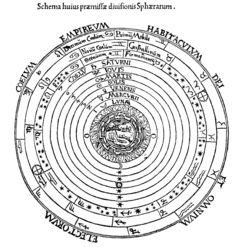Microcosm and Macrocosm
Macrocosm/microcosm is a Greek compound of μακρο- "Macro-" and μικρο- "Micro-", which are Greek respectively for "large" and "small", and the word κόσμος kósmos which means "order" as well as "world" or "ordered world".
The paired concept of Macrocosm and Microcosm is an idea that there is a corresponding similarity in pattern or nature or structure between human being and the universe. Some recognize active relationships between man and the universe based upon the idea of the similarity. The concept of macrocosm/microcosm views man as a small universe and the universe as anthropomorphic existence. This concept is found from the ancient thought to renaissance as well as in Buddhism and Upanishads, perhaps in other wider religious traditions. This idea, however, declined after seventeenth century along with the development of modern science. After modern times, this idea was mainly preserved in the realm of literature such as Novalis (1772 - 1801), a German romanticist poet, and Baudelaire (1821 – 1867), a French poet.
Ancient thought
In its most general sense, a cosmos is an orderly or harmonious system. It originates from a Greek term κόσμος meaning "order, orderly arrangement, ornaments," and is the antithetical concept of chaos. Today the word is generally used as synonym of the word 'universe' (considered in its orderly aspect). The word cosmetics originates from the same root.
The idea of the correspondence or some continuity between the cosmos and human being is found in Pythagoras in an incipient form. He, however, did not use the terminology of microcoms/macrocosm and did not have a clear anthropomorphic view of the cosmos.
Pythagoras is said to have been the first philosopher to apply the term "cosmos" to the Universe, perhaps from application to the starry firmament. The term so used is parallel to the Zoroastrian term aša, the concept of a divine order, or divinely ordered creation. Cosmos, thus, means not only the totality of the universe but it implies that the universe is ordered by the principle of harmony and balance. Pythagoras conceived the number or numerical ratio as the universal principle of harmony and understood that human aesthetic experience in music and art is closed tied to the orderly movement of stars. His understanding of the correspondence between the cosmos and man gave a framework of thought within which religious rituals, studies of mathematics and astronomy, and artistic activities are closed tied. Pythagoras and his religious sect offered solutions of mathematical questions to the divine and conceived mathematical exercises as religious practices to purify the soul.
Although Plato did not use the terminology, a clearer concept of macrocosm/microcosm is found in his Timaeus. He wrote on the idea of the soul of cosmos in its anthropomorphic representation:
Therefore, we may consequently state that: this world is indeed a living being endowed with a soul and intelligence ... a single visible living entity containing all other living entities, which by their nature are all related.
Plato, Timaeus, 29/30; 4th century B.C.E.
It also permeated the thinking of Hermetic philosophers and alchemists. The earliest known usage of this schema, among them, can be dated to the 3rd century CE by the Greek Olympiadorus, who stated, "the mythic Hermes calls man a small cosmos", the literal meaning of mikro-kosmos. Hermes Trismegistus's axiom As above, so below meaning that all that is in the Cosmos is mirrored in man the small universe, also reflects the macro/micro correspondence.
Medieval and modern thought
Throughout the Middle Ages the Macrocosmic quaternities of the elements and the seasons were linked to the Microcosmic quaternities of the four humours and ages of Man. The macrocosm/microcosm schema was developed further by the Swiss physician and alchemist Paracelsus, who proposed that within man was an inner heaven with stars. Paracelsus's philosophy of correspondences was based upon the belief that for every ailment and illness in Man (the microcosm) there existed a cure in nature (the macrocosm).
The English physician and alchemist Robert Fludd (1574-1637) expicitly based his work Utriusque Cosmi Historia (The history of the two worlds) upon the macro/micro correspondence; as does Sir Thomas Browne in his binary Discourses of 1658: Hydriotaphia, Urn Burial depicts the small, temporal world of man, whilst The Garden of Cyrus represents the macrocosm, in which the ubiquitous and eternal quincunx pattern is discerned in art, nature and the Cosmos.
The great enigma of alchemy is the mystery between the macrocosm and microcosm. Equally an unsolved enigma of English literature is the relationship between Browne's diptych Discourses: the microcosm world of Hydriotaphia, Urn Burial and the macrocosm world of The Garden of Cyrus.
See Also
- Family as a model for the state
- Golden Mean
- Surat Shabda Yoga
- Rose Cross and Alchemy
ReferencesISBN links support NWE through referral fees
- Republic, Plato, trans. By B. Jowett M.A., Vintage Books, NY. § 435, pg 151
Bibliography
- Theories of Macrocosms and Microcosms in the History of Philosophy, G. P. Conger, NY, l922, which includes a survey of critical discussions up to l922.
External Links
de:Mikrokosmos
Credits
New World Encyclopedia writers and editors rewrote and completed the Wikipedia article in accordance with New World Encyclopedia standards. This article abides by terms of the Creative Commons CC-by-sa 3.0 License (CC-by-sa), which may be used and disseminated with proper attribution. Credit is due under the terms of this license that can reference both the New World Encyclopedia contributors and the selfless volunteer contributors of the Wikimedia Foundation. To cite this article click here for a list of acceptable citing formats.The history of earlier contributions by wikipedians is accessible to researchers here:
The history of this article since it was imported to New World Encyclopedia:
Note: Some restrictions may apply to use of individual images which are separately licensed.
